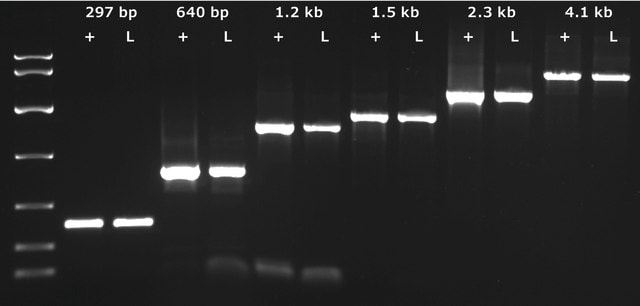PFABIKB
Roche
KAPA PROBE FAST
suitable for qPCR, 2 ×, ABI Prism®
Sinónimos:
probe qPCR, qPCR
About This Item
Productos recomendados
Quality Level
shelf life
≤12 mo.
packaging
kit of 1 mL (100 x 20 μL rxn; KK4705)
kit of 10 mL (1000 x 20 μL rxn; KK4707)
kit of 5 mL (500 x 20 μL rxn; KK4706)
kit of 50 mL (5000 x 20 mL rxn; KK4714)
pkg of
manufacturer/tradename
Roche
concentration
2 ×
technique(s)
qPCR: suitable
compatibility
for use with Applied Biosystems® 5700
for use with Applied Biosystems® 7000
for use with Applied Biosystems® 7300
for use with Applied Biosystems® 7700
for use with Applied Biosystems® 7900HT
for use with StepOne™
for use with StepOnePlus™
storage temp.
−20°C
¿Está buscando productos similares? Visita Guía de comparación de productos
General description
Application
- Gene expression analysis
- Multiplex qPCR
- SNP genotyping/allelic discrimination
- Microarray validation.
- Reverse transcription (RT)-PCR/RT-qPCR
- Quantitative polymerase chain reaction (qPCR)
- Genotyping
Features and Benefits
- Exceptional differentiation of heterozygous and homozygous alleles
- Discrete clusters in SNP genotyping assays
Achieve excellent reproducibility and efficiency:
- Fast, high performance five-colored multiplex PCR
- Similar abundance levels achieved with low copy number
- Broad dynamic range of up to 10 orders of magnitude
Increase flexibility:
- Compatible with both standard and fast cycling protocolsRetain accurate quantification
Quick Notes:
- These kits are compatible with all fluorogenic probebased technologies, including hybridization probes (e.g., FRET), hydrolysis probes (e.g., TaqMan®) and displacement probes (e.g., molecular beacons).
- Initial denaturation for 20 sec at 95ºC is sufficient for enzyme reactivation; however, optimal denaturation of complex targets may require up to 3 min denaturation.
- For 2-step cycling, use 30 sec combined annealing/ extension/data acquisition.
- For 3-step cycling, use 20 sec for primer annealing and 1 sec for extension/data acquisition.
- Do not exceed 25 μL volumes.
- Compatible with different qPCR protocols
Quality
Preparation Note
KAPA PROBE FAST qPCR Master Mix (2X) ABI PRISM® is stable through 30 freeze-thaw cycles. Ensure that all reagents are stored protected from light at -20°C when not in use. When protected from light, reagents are stable in the dark at 4°C for at least one week, and may be stored at this temperature for short-term use provided that they do not become contaminated with microbes and/or nucleases.
Other Notes
Legal Information
Solo componentes del kit
- qPCR Master Mix
- ROX™ High incorporated in the reaction mix
- KAPA Taq HotStart® DNA Polymerase
- dNTPs
- MgCl2 5 nM
Storage Class
12 - Non Combustible Liquids
wgk_germany
WGK 1
flash_point_f
does not flash
flash_point_c
does not flash
Certificados de análisis (COA)
Busque Certificados de análisis (COA) introduciendo el número de lote del producto. Los números de lote se encuentran en la etiqueta del producto después de las palabras «Lot» o «Batch»
¿Ya tiene este producto?
Encuentre la documentación para los productos que ha comprado recientemente en la Biblioteca de documentos.
Los clientes también vieron
Artículos
An overview of directed evolution and the methods for generating proteins with optimized or entirely new functions.
Nuestro equipo de científicos tiene experiencia en todas las áreas de investigación: Ciencias de la vida, Ciencia de los materiales, Síntesis química, Cromatografía, Analítica y muchas otras.
Póngase en contacto con el Servicio técnico












